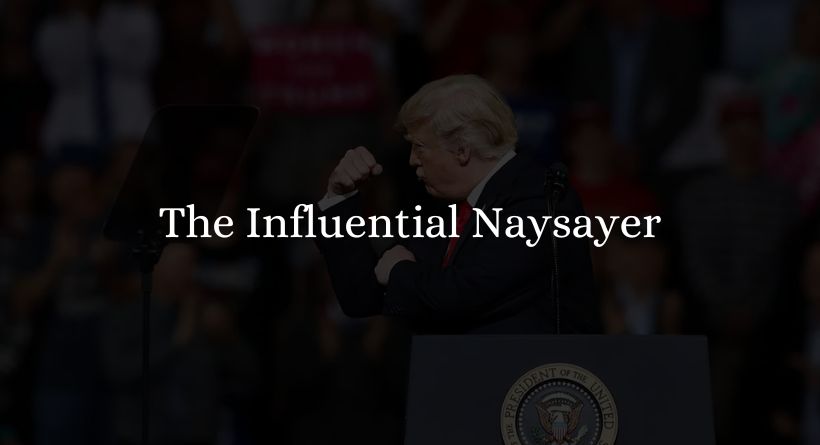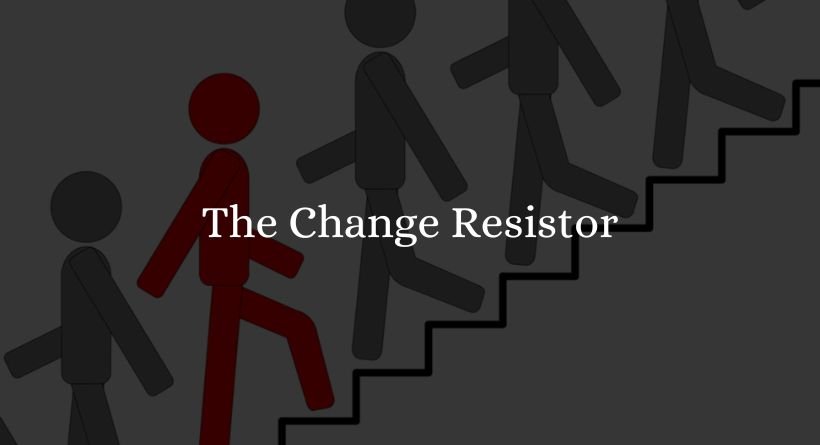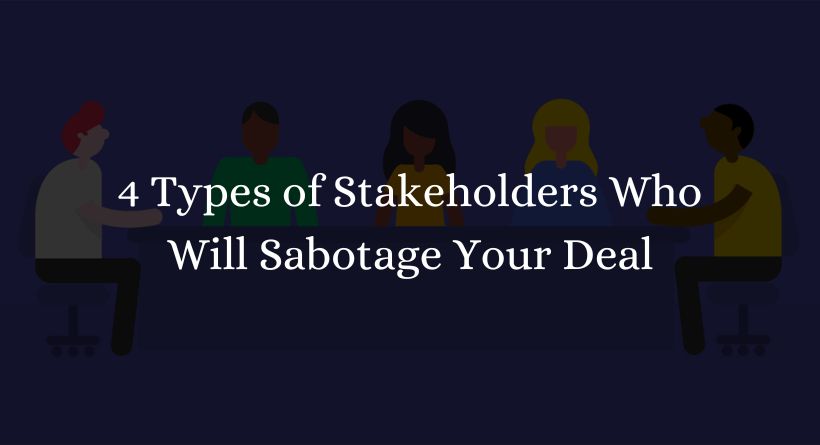Are you tired of encountering roadblocks and hurdles that sabotage your deals?
In the world of business, stakeholders play a crucial role in the success or failure of any deal.
However, not all stakeholders are aligned with your objectives, and some may even actively work against you.
In this blog post, we will delve into the four types of stakeholders who can potentially sabotage your deals and provide you with effective strategies to navigate these challenges.
We understand the frustration and disappointment that can arise when stakeholders impede your progress.
But fear not, because we are here to equip you with the knowledge and tools to overcome these obstacles and secure successful deals.
By identifying these problematic stakeholders and implementing the right strategies, you can regain control of your deals and increase your chances of achieving your desired outcomes.
Throughout this blog post, we will explore each type of stakeholder, delve into their motivations and behaviors, and offer practical tips and strategies to mitigate their negative impact.
From understanding their perspectives to influencing their decision-making process, we will guide you through the intricacies of stakeholder management.
By the end of this article, you will be well-equipped to navigate the complex landscape of stakeholder dynamics and turn potential saboteurs into valuable allies.
So, let’s dive into the world of stakeholders and uncover the strategies that will empower you to overcome their challenges, secure your deals, and propel your business forward.
Type 1: The Hidden Obstructer
Stakeholders come in various forms, and one type that can wreak havoc on your deals is the hidden obstructer.
These individuals possess a unique ability to conceal their intentions and subtly hinder your progress.
Often driven by personal motivations or conflicting agendas, hidden obstructers can jeopardize the success of your endeavors without ever revealing their true intentions
Identifying and managing hidden obstructers requires a keen sense of observation and understanding of their underlying motivations.
They may exhibit behaviors such as passive-aggressiveness, subtle resistance, or undermining your efforts behind the scenes.
By paying close attention to their actions and recognizing the patterns, you can proactively address their influence and minimize their impact.
Strategies for managing hidden obstructers involve open communication, building trust, and gaining insights into their motivations.
It is crucial to foster an environment where they feel comfortable expressing their concerns or objections openly.
By acknowledging their perspectives and addressing their underlying issues, you can potentially turn them into allies and align their interests with your objectives.
Real-life case studies and examples provide valuable insights into dealing with hidden obstructers.
For instance, consider a scenario where a key stakeholder seemingly supports your deal but subtly creates roadblocks through delaying tactics or spreading rumors.
By recognizing the signs and utilizing effective communication and conflict resolution techniques, you can navigate these challenges and salvage the deal.
Also Read: What the July 2025 Legislation on Firefighting Foam is All About
Type 2: The Influential Naysayer

In every deal, there’s likely to be an influential naysayer—a stakeholder who holds significant sway over others and possesses the power to sway decisions in a negative direction.
Their skepticism, doubts, or outright opposition can cast doubt on your proposal, making it challenging to gain the necessary buy-in from other stakeholders.
Understanding the role and influence of influential naysayers is crucial for effectively addressing their negative impact.
They may have legitimate concerns or biases that shape their opposition, but their influence can hinder progress if not managed properly.
By comprehending their motivations and perspective, you can tailor your approach to address their specific objections.
Techniques for addressing and neutralizing the influence of influential naysayers involve active listening, empathy, and presenting compelling evidence and arguments.
By actively engaging with them, seeking to understand their reservations, and addressing them head-on, you can gradually build a bridge of understanding and potentially turn them into advocates for your deal.
Real-life anecdotes highlight successful approaches in dealing with influential naysayers.
Consider a situation where a senior executive expresses strong doubts about the feasibility of your proposal.
By conducting thorough research, gathering data, and preparing a persuasive presentation that addresses their concerns, you can demonstrate the viability and benefits of your deal, ultimately swaying their opinion and gaining their support.
Type 3: The Overbearing Controller
Dealing with an overbearing controller can be a formidable challenge in securing successful deals.
These stakeholders have a strong desire to maintain control and dominance, often imposing their will on others and disregarding alternative perspectives.
Their tendencies can lead to power struggles, resistance to change, and stifled collaboration.
Recognizing the traits and tendencies of overbearing controllers is crucial for maintaining a balanced power dynamic.
They may exhibit behaviors such as micromanagement, dismissing ideas that deviate from their own, or displaying a need for constant validation of their authority.
By understanding these characteristics, you can navigate the relationship more effectively.
Methods for establishing a balanced power dynamic with overbearing controllers involve assertiveness, diplomacy, and setting clear boundaries.
It is essential to assert your expertise and value while respecting their position and authority.
By finding common ground, leveraging their strengths, and diplomatically challenging their assumptions, you can influence the decision-making process and gain their respect.
Practical tips for managing relationships with overbearing controllers include maintaining open lines of communication, focusing on shared goals, and seeking opportunities for collaboration.
By fostering an environment of mutual trust and respect, you can navigate the challenges posed by overbearing controllers and foster a more productive working relationship.
Type 4: The Change Resistor

Change is inevitable in any business or organization, and dealing with stakeholders who resist change can significantly impede your progress.
Change resistors are individuals who are reluctant to embrace new ideas, processes, or initiatives.
They often cling to the status quo, fearing the unknown or perceiving change as a threat to their established ways of doing things.
Understanding the mindset and resistance patterns of change resistors is essential for effectively engaging them.
They may exhibit behaviors such as skepticism, fear, or a preference for maintaining the current state.
By unveiling their underlying concerns and motivations, you can tailor your approach to address their specific objections and alleviate their resistance.
Approaches for engaging change resistors and overcoming their objections involve clear communication, empathy, and demonstrating the benefits of change.
It is crucial to articulate a compelling vision, outline the advantages of the proposed changes, and address their fears or reservations directly.
By involving them in the decision-making process and allowing them to voice their concerns, you can foster a sense of ownership and reduce resistance.
Expert advice and best practices for fostering collaboration with change resistors can offer valuable insights into navigating these challenging situations.
For instance, establishing a pilot program to test the proposed changes on a smaller scale can help alleviate their fears and build confidence.
Additionally, providing training and support during the transition can empower change resistors and facilitate their acceptance of new ways of working.
Remember, change resistors can become powerful allies once they recognize the benefits of change and align their interests with the organization’s goals.
Stay tuned for the next section, where we will delve deeper into expert strategies and best practices for engaging change resistors and fostering collaboration that leads to successful transformations.
Conclusion
Throughout this article, we have explored the various types of stakeholders who can potentially sabotage your deals and hinder your progress.
From hidden obstructers to influential naysayers, overbearing controllers, and change resistors, each type presents unique challenges that require careful navigation and proactive management.
By understanding the characteristics, motivations, and resistance patterns of these stakeholders, you are better equipped to address their concerns, overcome objections, and foster collaboration.
We have provided strategies, techniques, and expert advice to help you identify, engage, and manage each type effectively.
In summary, the key to successfully managing stakeholders lies in proactive communication, empathy, and the ability to adapt your approach to suit their specific needs and motivations.
By building trust, addressing objections, and demonstrating the value of your proposals, you can transform stakeholders into valuable allies who actively contribute to the success of your deals.
Now, armed with the knowledge and strategies shared in this article, it’s time to put them into action.
Implement the recommended approaches, adapt them to your unique circumstances, and observe the positive impact they have on your stakeholder relationships and deal outcomes.
Remember, managing stakeholders is an ongoing process that requires continuous effort and refinement.
Embrace the challenges and view them as opportunities for growth and learning.
With persistence and the right strategies, you can turn potential obstacles into stepping stones toward achieving your goals.
FAQs (Frequently Asked Questions)
Q: How do I identify hidden obstructers?
A: Hidden obstructers often work behind the scenes and may not express their objections openly. Look for subtle signs such as passive-aggressive behavior, undermining actions, or resistance to change. Pay attention to their interactions and seek feedback from other stakeholders to uncover their influence.
Q: How can I address the negative impact of influential naysayers?
A: When dealing with influential naysayers, it’s important to address their concerns directly and engage them in constructive dialogue. Provide factual information, share success stories, and involve them in the decision-making process to alleviate their skepticism and neutralize their negative influence.
Q: What strategies can I use to establish a balanced power dynamic with overbearing controllers?
A: Balancing power dynamics with overbearing controllers requires setting clear expectations, asserting your expertise, and establishing boundaries. Maintain open communication, focus on collaborative problem-solving, and seek win-win solutions that address both their needs and the overall project objectives.
Q: How can I engage change resistors and overcome their objections?
A: Engaging change resistors involves understanding their mindset, addressing their concerns, and involving them in the change process. Create a safe space for open dialogue, provide training and support, and demonstrate the benefits of change through tangible results and success stories.


